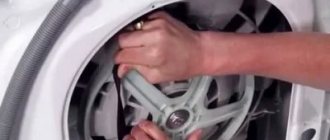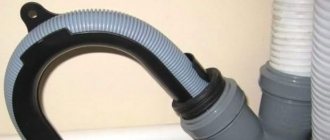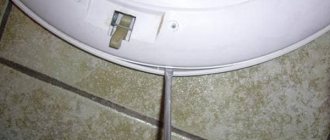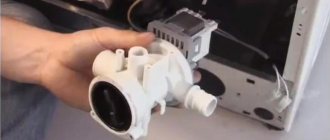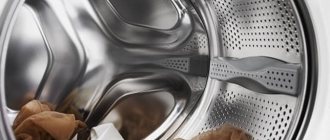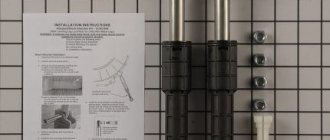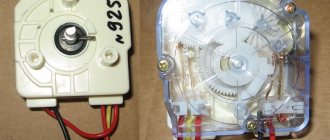Most washing machine breakdowns result in puddles on the floor. Damage to the hose can be one of the reasons for improper operation or breakdown of the washing unit. Let's figure out what to do if the water supply hose (filler) breaks, bursts, or becomes unusable over time. We will analyze the most common breakdowns and methods for eliminating them.
The manual is relevant for: Ardo / Ardo, Beko / Beko / Veko, Bosch Avantixx, Classixx, Logixx, Maxx, SportLine / Bosch Avantix, Classic / Classic, Logix, Max, Sportline; Brandt / Brandt, Candy Aquamatic, Holiday, CNE, CTS / Candy Aquamatic, Holiday; Daewoo / Daewoo, DEXP / Dexp, Electrolux Time Manager / Electrolux, excuse me, Timemanager, Evgo / Evgo, Gorenje / Gorenje, Haier / Hayer, Hansa / Hansa, Hotpoint Ariston Margherita, RSM, ARSL, ARWM / Hotpoint Ariston Margherita, Indesit IWSB , WISL, WISN, WITL, Innex / Indesit Wisl, Inex; LG / LJ/LV; Miele / Miele, Samsung Diamond, WF, EcoBubble, Bio Compact / Samsung Diamond, Eco Bubble, Bio Compact; Siemens / Siemens, Vestel / Vestel, Whirlpool AWG / Whirlpool, Zanussi Aquacycle, EcoValve / Zanussi Aquacycle, EcoValve; Atlant, Vyatka, Desna, Donbass, Malyutka-2, Saturn, Siberia, Fairy-2, Eureka-3 and other brands with vertical and horizontal loading, automatic and semi-automatic.
So, let's go!
Causes of leaks
Shell damage
One of the reasons for damage to the inlet hose may be damage to the casing (rubber part) caused by kinking, movement of equipment, external mechanical impact or long service life of the unit.
Sometimes it is quite difficult to identify the cause of a leak by dripping water. Microcracks in the material often occur in hard-to-reach places, for example, in the places where fittings are connected, or during the transition from metal to rubber. It all starts with the formation of “condensation” and small droplets on the floor and ends with a flood.
In this case, it is necessary to disconnect the connectors and carefully check for leaks in a visible place, in good lighting. If leaks are detected and the rubber shell is not sealed, it is recommended to say goodbye to the old product and buy a new one. In this case, sealing or sealing cracks is ineffective, since the filler tube, when the washing machine is operating, will periodically be under water pressure and most likely a leak will occur again.
The internal filter is clogged
If water does not flow well into the tank, the inlet valve filter may be clogged. A clogged filter must be removed from the machine and cleaned. On all machines, this filter is installed in the process hole in front of the fill valve. It looks like a round plastic mesh with small holes.
Due to the impurities and suspended particles contained in tap water, there is a high chance that the filter will become clogged over time. The pressure will become weak and it is possible that the connections to the water supply will begin to be undermined. Installing additional water filters on the incoming pipe will reduce the load on the filter, but does not completely solve the problem. The filter still requires periodic cleaning.
The cleaning procedure is not complicated, does not require experience or specialized knowledge, and can easily be done without turning to specialists.
How to fix the fill valve in a washing machine with your own hands
The nuts are loose
If none of the previous problems occur, vibration may have caused the lug nuts to become loose. To fix it, tighten the clamping nut.
10 reasons why the washing machine shakes and rattles during the spin cycle
Other damage
A leak in the washing machine can be associated not only with problems in the inlet hose, but also with a number of other reasons:
- Wear of rubber gaskets or seals in the connection;
- Plastic fittings pinch the rubber gasket, because of this the seal is not level and allows liquid to pass through;
- Leakage from pipes inside the housing;
- Torn hatch cuff;
- Accumulated condensation;
- Rotten heating element;
- Hole in the tank;
- Strong pressure changes in the water supply system, sometimes the pipes can twitch;
- And others.
Incorrect position
Another reason for a leak associated with the inlet hose may be incorrect placement - at the junction with the pipe it is strongly bent and pinched. In this case, it is necessary to move and install the washing machine correctly so that there is no tension or kinks.
If the length is not enough, buy a repair kit for extension, but more on that below.
How to replace
If you need to replace the hose, use the step-by-step instructions:
- turn off the water supply in the water supply pipes using the inlet valve;
- remove the old spare part by unscrewing it from the connection point to the water supply;
- install the gaskets from the kit;
- attach the new part, tighten it well at the fastening points - do not apply too much force, as the plastic parts may burst;
- turn on the water supply;
- check for any leaks (if you screw it on tightly enough, the gasket is at the right angle and the nut goes along the threads, then there should be no leaks or “snot”);
- if it leaks, tighten the nuts at the fastening points more tightly. It is necessary to pay attention to the fact that you cannot apply strong forces, so as not to break the thread (do not overdo it, especially with plastic components). It is better to unscrew the structure, adjust the rubber band and try again, tightening the nuts along the threads.
Before starting the procedures, be sure to close the water supply tap to reduce the pressure and wait a couple of minutes. If this is not done, the forces applied when unscrewing can lead to defects in both the tap and the fitting. After dismantling the damaged element, a new one should be installed in accordance with the instructions provided.
Before purchasing, be sure to check the length of the hose and the diameters of the fittings for connection. Alternatively, you can take the old pipe with you to the store and use the advice of specialists when selecting a new one.
The water supply hose in the washing machine is leaking: reasons
Often, after installing a washing machine, during washing, we may find a puddle on the floor. This is very bad, because it can cause a short circuit or electrocute someone in the household. Therefore, the problem should be resolved immediately.
Causes of water supply hose leaking:
- One possible cause is a broken washing machine inlet hose. Perhaps the hose is intact, and the breakdown is related to the junction of the hose with the water supply.
- A leaking water supply hose may be caused by a poor connection . This happens if during installation the technician did not tighten the connection properly, so there is a gap. Because of this, a leak appears at the junction.
- Incorrect hose position. This happens when the hose at the junction with the pipe is bent and pinched. This causes a leak. In this case, it is necessary to install the hose correctly by changing its position.
- Gasket wear . This happens if your washing machine is old enough. Due to constant mechanical vibrations and high water pressure, the gasket wears out. This causes a problem.
- Poor connection between plastic and rubber in the hose. The fact is that over time, rubber loses its elasticity and shape. Therefore, it is poorly fixed and leakage occurs. Often this problem appears when you change the position of the car, if you move or change location in the apartment.
The water supply hose in the washing machine is leaking
How to lengthen
If you have a situation where the length of the water hose to connect to the water supply network is insufficient, you can buy the required length, or lengthen the existing one.
To do this you need:
- measure the length of the missing part;
- purchase a product of the required length;
- buy an adapter or coupling of a suitable diameter;
- disconnect the old one from the connecting insert;
- connect the products through special adapters (to seal the connection, it is recommended to use fume tape for water connections; you can apply sealant on top);
- connect the extended hose to the tap and install the machine in place.
When installing the water intake hose, do not install it under tension. If the washing machine vibrates or moves, it may break. If this happens in the absence of the owners, the need for repairs may arise, both at home and at the neighbors on the floors below.
For normal operation of the machine, it is not recommended to install a part longer than 3 meters. There is a large selection of hoses at the plumbing store, so you can easily purchase a new one.
Most often, difficulties arise with the acquisition of spare parts of non-standard sizes, that is, longer than the standard length of 1-1.5 meters. In this case, it is easier to connect two tubes into one using couplings.
Repair and cleaning of the filler pipe
The pipe is located directly under the body of the washing machine, so it must first be disassembled.
A certain sequence must be followed here. Cleaning sewer pipes with soda and vinegar
You need to make sure that the flow of water into the machine is blocked. Next, the washing machine should be disconnected from the electricity. The compartment for receiving powder is removed. The garbage filter is removed. Place the washing machine on a prepared blanket or rag on a free area of the floor. The machine should be carefully placed on the side wall.
If there is water in the machine, it should be removed. If this is not done, you may damage the control module of the washing machine. Next, having removed the top cover of the machine using a screwdriver, you can see in the upper left corner a rubber pipe that comes from the water inlet. Using pliers, carefully, trying not to damage them, since they will be attached back, you should unclench and move the clamps that hold it towards the middle of the pipe. Next, remove the filler pipe and determine its condition. If there are blockages, they need to be removed; if damage is observed, a new suitable pipe should be purchased.
The quality of washing directly depends on the components of the washing machine and proper care of them. If, due to a breakdown, it was necessary to replace or repair any parts, you should approach the solution of the problems that have arisen with all seriousness, and if you purchase new components, do not skimp and opt for higher quality materials.
Connection diagram
When connecting a hose for water supply, you can either invite a specialist or do it yourself. All standard washing machines are connected to the cold water supply pipeline using the one included in the standard delivery package (the length of foreign manufacturers is 120 or 150 cm). To do this, a pipe with a diameter of ¾ inch, bent at an angle of 90 degrees, is screwed to the back wall of the machine (for this purpose, there are protrusions for fingers on the threaded nut), and the second end, using an American pipe having a seal with a plumbing gasket, is connected to the water supply pipe. At the place where the inlet hose is connected to the water supply pipeline, a tie-in is made in advance by installing a tee and a separate valve for local shut-off of the water supply.
To correctly independently connect the washing machine to the water supply network, we recommend using step-by-step instructions.
Step-by-step instructions for connecting any washing machine
Connection of the rubber and plastic parts of the hose
A leak may occur in the hose itself, where the rubber part is connected to the plastic part using an iron clamp. As with the gasket, the rubber hose loses its elasticity over time, and accordingly the pressure of the iron girth weakens and water begins to leak through the connection.
Leaks occur more often when the machine is moved and the old connection is disturbed. To eliminate the leak, you need to correct and firmly fasten the hose to the back wall of the machine. If this does not help, replace the inlet hose.
[custom_ads_shortcode3]
A little theory
Purpose
One of the important components that ensures the smooth and reliable operation of washing machines is hoses. Each washing machine is equipped from the factory with: inlet and drain. During the installation process, it is important to check that there are no cracks, bends, punctures or other defects. The filler connects directly to the water supply. The drain, which can also be extended if necessary, is connected to the sewer pipeline, through a siphon or directly.
How to choose
In order for a new hose for a washing machine to last a long time, you need to make the right choice when purchasing it and take into account several important points:
- length, as mentioned above, is a very important parameter affecting the reliability of the washing machine;
- the operating pressure is selected taking into account the pressure in the water supply network in your home, usually 2.5-7 atmospheres;
- The maximum temperature must be designed for temperatures greater than 90°C.
The most popular and less high-quality brands: Aquatechnician (Russia), Magic Power (China), Swedish Electrolux with aquastop, Turboflex (Russia), Reflex (Italy).
Causes of leakage during washing and spinning
Since the technological operations during the washing and spinning process are fundamentally no different from each other (draining during spinning occurs according to the same scheme as during washing), it makes sense to consider the reasons for the appearance of water in the machine together.
One of the most common causes of leaks during operation of a washing machine is a malfunction of the drain pump or filter. The first element is necessary for directly pumping water out of the working volume during any operation, and even the smallest solid object found inside the washing machine can damage it.
Due to its small size, it can not only fly through the drain pipe, reaching the filter, but also knock it out due to its enormous speed (the average rotation speed of a washing machine drum is 1,000 rpm, so a conventional coin has a very decent starting speed) , which can damage the pump. Obviously, for the same reason, the filter can quickly become unusable.
Figure 3 – Drain pump
If water mainly accumulates at the back wall of the device, the cause is probably a malfunction of one of the two seals. The oil seal is another sealing device that is designed to prevent the formation of leaks from the drum bearings, which, in turn, ensure quiet operation of the machine. Therefore, if a leak is accompanied by a multiple increase in noise compared to what usually comes from the machine, this is a sure sign that the problem lies either in it or in the bearing.
Note: manufacturers strongly recommend that such an oil seal device be lubricated annually with a water repellent, as this will ensure a better degree of sealing of the structure.
Varieties
Regular
The most common inlet hoses, without a leakage protection system, which are sold in any hardware store:
- rubber water pipe - standard for connecting equipment to the water supply network, usually included in the kit, service life 3-10 years;
- reinforced (available in corrugated metal braid), which is a standard rubber tube protected by an additional layer, which gives additional strength. Metal and nylon are used for reinforcement.
With mechanical valve
The rubber hose for water supply with the Aquastop system is one of the first with protection against leaks.
Aquastop is a valve with a special spring that is instantly activated when the pressure changes. If the Aqua-Stop system detects an unexpected leak in the washing machine, then the water that at that moment enters the unit is immediately shut off.
A special feature of this system is a thick water supply tube that can withstand up to 70 bar, when a standard water supply can only withstand 10 bar. This mechanism contains a solenoid valve (safety valve). Its normal position is normally closed.
Water Block # Blocking valve
The principle of operation of the Water Block water shut-off valve is to determine the volume of water that has passed through the sensor. "Water Block" is installed at the water inlet. The valve does not allow more water to pass through than specified in the program; it blocks the access of liquid. This system reacts even to small leaks, since the pressure inside the water supply does not matter to the device. After an alarm is triggered, the system starts a new operating cycle only after it is reset by pressing the “Reset” button.
The user of the system can adjust the permissible water level independently - the delivery set includes a key for setting the required parameters. For correct settings, you need to know information about the water consumption of the washing machine for one operating cycle.
With powder adsorbent
Some modern manufacturers equip washing machines with inlet hoses containing absorbent powder. This system is equipped with an internal channel through which water flows, and an external tube hermetically seals the internal flow. If the internal channel is damaged for some reason, water will begin to flow into the outer shell and rise to the automatic blocker. The mechanism is located at the point where the hose connects to the water supply pipeline. There are two types of protective devices in such systems:
- a plunger that performs the function of a shut-off valve. The absorbent component is connected to the plunger using a spring. When the absorbent powder comes into contact with water, it expands and begins to press on the spring and the plunger closes the entire system;
- magnets ensuring a stable position of the plungers. Dry absorbent powder keeps the system in balance. When wet, it expands in volume and separates the two magnets. As a result, the field between the magnets weakens, and the flow is cut off by the plunger.
Such a system gives results only if there is a leak in the hose. If the depressurization occurs on the threads or inside the washing machine, the mechanism simply will not work, as with small leaks.
Another disadvantage of the system is its disposability, i.e. After an emergency, the system requires complete replacement.
With float sensor
Another leakage protection system built into washing machines by manufacturers is a float sensor with a switch (much like dishwashers). In this case, the lower part of the household appliances is covered with a decorative plastic tray. If a leak occurs at the junction of the pipes or a leak occurs inside the unit, the liquid begins to collect in a special container. The float sensor, protection system, rises as the liquid level in the container rises. After some time, the mechanical leak valve will activate the switch, stopping the flow of water into the tank.
The disadvantage of such a system is that the protection mechanism only works when water collects in a special container. If water accumulates on the floor, the switch will not work. In addition, the mechanism does not respond to small leaks.
The washing machine is leaking from the door
The main cause of machine leakage is the door seal. Wear and tear leads to holes or abrasions, which causes water to leak inside the machine, which can then seep out from underneath the machine itself or leak from the door. It is worth noting that ruptures may not always be in the lower part; they also appear in the upper part and cause water leakage during spinning or rinsing.
If water is found on the front of the machine, the rubber seal should be inspected, but before doing so, it is necessary to ensure that there is no possibility of water leaking from the powder tray. A slight leak of water from the dispenser can flow down to the door in a thin path and create the appearance of water leaking from the door.
Wear of the rubber seal is a common cause of water leaking from the door. When the door is closed, the glass presses on the seal, forming a tight seal. Wear may be caused by chips and cuts. Perhaps it has simply worn out, that is, it has become hard and wavy, in which case it will need to be replaced.
Sometimes a leak can occur when an object gets between the glass and the seal, disturbing the seal. It is important to clean the door seal and glass from the inside where they come into contact while the machine is running. Such objects can be hairs, undissolved detergent, pieces of clothing, and scale.
What to do first?
What to do if you notice water leaking from under the washing machine during operation?
- First, unplug your washing machine without stepping into any spilled water. If it is impossible to approach the device “dry,” turn off the power supply to the power distribution board.
- Turn off the water supply tap to the faulty equipment.
- Drain all the water from the washing machine using the emergency drain filter - it is located in the lower right corner on the front panel of the machine. Now you can remove the consequences of flooding.
- Free the machine from the laundry and begin the inspection.
